It looks like you're using an Ad Blocker.
Please white-list or disable AboveTopSecret.com in your ad-blocking tool.
Thank you.
Some features of ATS will be disabled while you continue to use an ad-blocker.
share:
originally posted by: cooperton
Yeah you rely on blind faith
Says the person relying on blind faith that the Old Testament is literal truth. It's not 'blind faith' to believe the educated experts and the facts. It's using your head and understanding the facts and information, listening to those who know more than you do and who are educated in the fields, and accepting it.
Because you're treating the dates as dogmatic facts, and also trying to use the made-up dates to support your claims that I don't believe are true.
They aren't 'made up dates'. They are educated conclusions based on evidence.
Moses not referencing other survivors does not mean that it invalidates the flood if there were other survivors. You are the one not realizing that the multiple other accounts corroborates the whole
It's not the case of Moses simply not referencing other survivors. The Bible specifically states that the entire world was destroyed, all people and animals and plants, other than what was on the ark. Supposedly we are all related to Noah. Stating that there were people around the world who survived, and evidence shows they even flourished during that time, doesn't corroborate the Noahs Ark Flood story .. it destroys it. Considering that all those people around the world spoke their own languages it also destroys the premise of The Tower of Babel claiming that all people of the world spoke one language. It clearly didn't. But that's for another thread, not this one.
edit on 10/15/2023 by FlyersFan because: (no reason given)
originally posted by: FlyersFan
Says the person relying on blind faith that the Old Testament is literal truth.
No it's not blind faith. I'm corroborating the global flood account of the Sumerians, Incans, Hebrews, etc, etc:
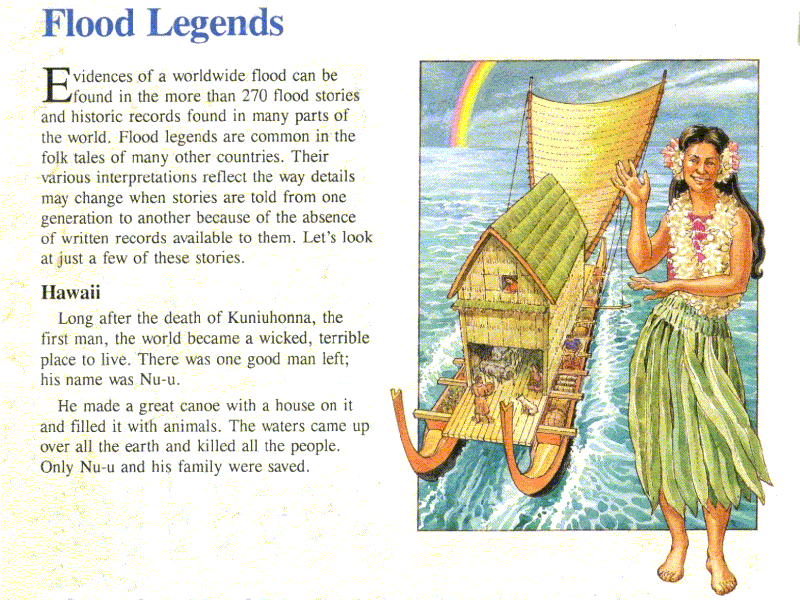
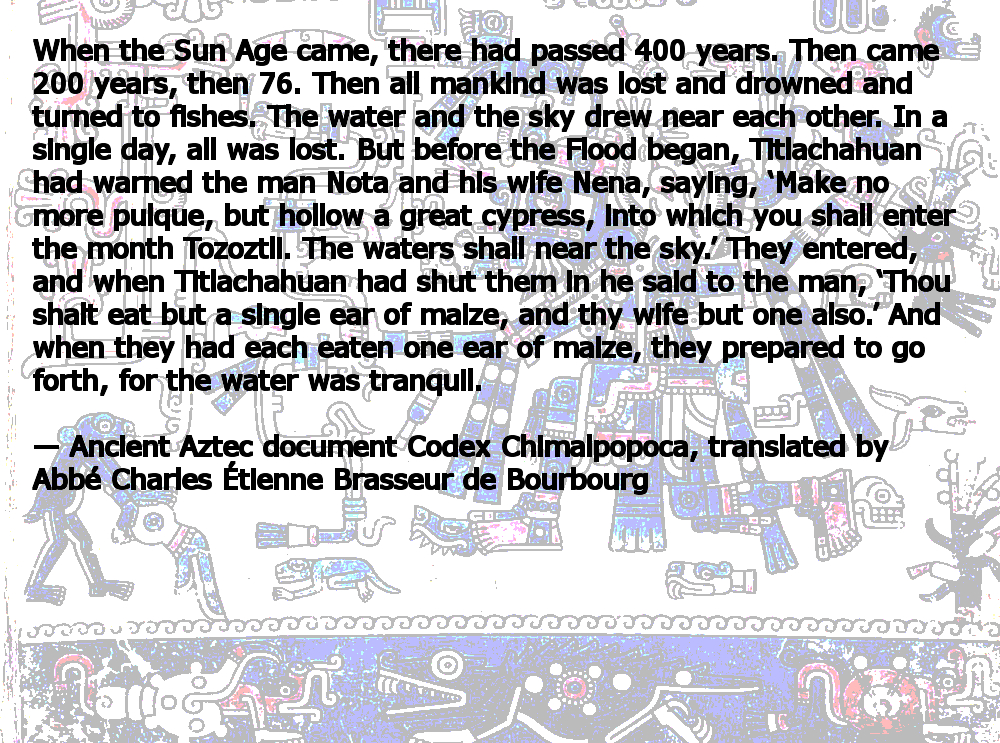
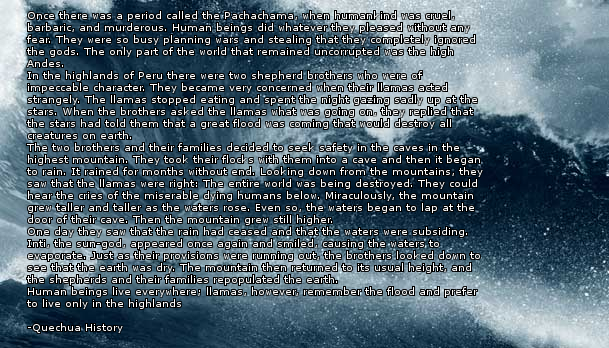
called “Llocllay Pachacuti” by the Quechua, meaning “universal flood.”
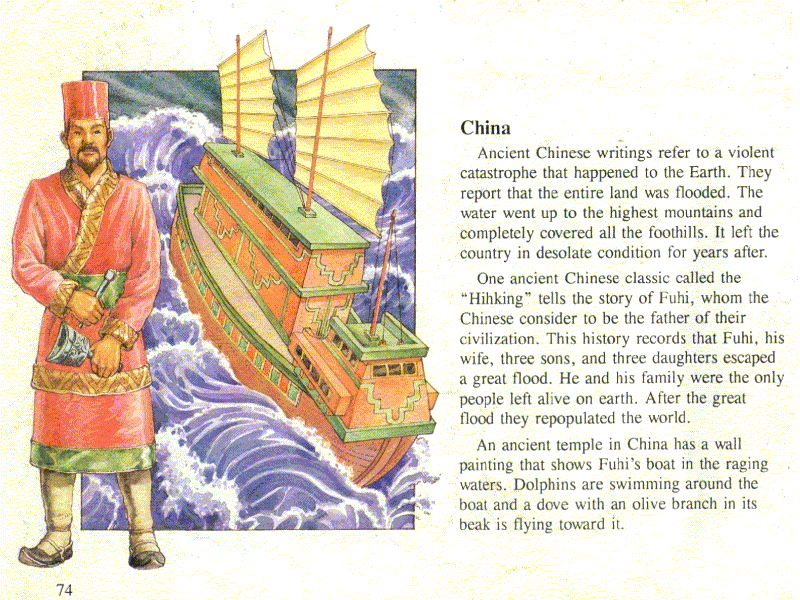
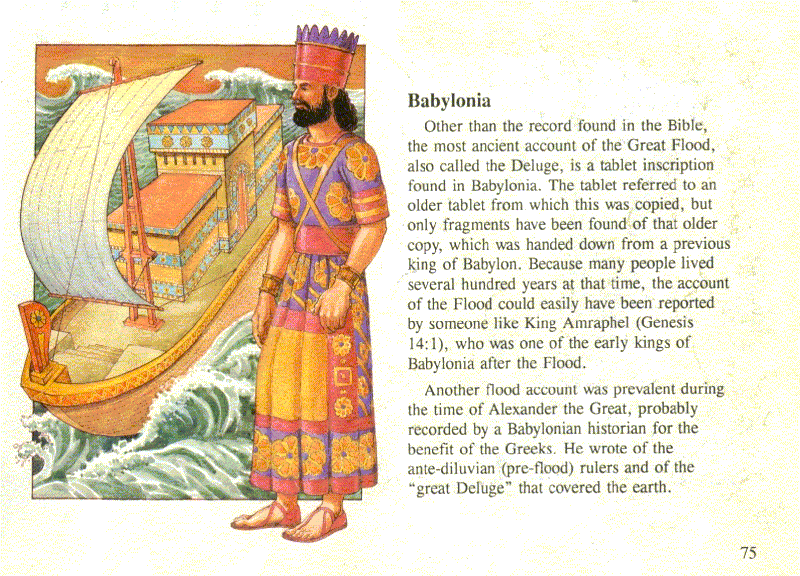
They aren't 'made up dates'. They are educated conclusions based on evidence.
You haven't shown any evidence.
originally posted by: cooperton
I'm corroborating the global flood account of the Sumerians, Incans, Hebrews, etc, etc:
AND THE POINT IS ... there had to be people alive and well in all those cultures to supposedly live through the events and tell the stories. Therefore, the story of Noahs Flood, as it is told in the Bible, is false. The bible says that ONLY Noah and his family survived. That ONLY the animals on the ark survived. That the whole purpose of the flood was to destroy evil and only Noah was good. If those other stories are being told because there were floods in those cultures and people survived to tell about it, then the biblical account is FALSE. Noah and his family were not the only people in the world to survive .... TONS of others did. The animals on the ark were not the only animals to survive ... TONS of others did. All the plants in the world were destroyed .... Plants survived all over the world. Noah wasn't the only good person on earth and the flood wasn't to destroy evil as the Bible claims. FALSE STORY.
You haven't shown any evidence.
The conclusions by the experts are based on solid evidence. As I said, I'm not writing a college level egyptology book on how artifacts are collected and dated. The evidence I've shown is well sourced and excellent. You choose to reject it because there isn't a text book on Egyptology included. Your choice.
edit on 10/15/2023 by FlyersFan because: (no reason given)
originally posted by: FlyersFan
AND THE POINT IS ... there had to be people alive and well in all those cultures to supposedly live through the events and tell the stories.
Yet you couldn't present evidence for even one cultures existing through these dates. Just speculative blog articles that don't cite why they came to their conclusion on the dates.
originally posted by: cooperton
Yet you couldn't present evidence for even one cultures existing through these dates. Just speculative blog articles that don't cite why they came to their conclusion on the dates.
Yes I did. I did not post 'speculative blog articles' with the Egyptian culture. I posted the dates of the dynasties. These are the accepted dates through all of Egyptology. And I said why they came to the conclusion for those dates .... ARCHEOLOGY, SCIENCE, HISTORY, EGYPTOLOGY ... experts in the field have seen all the evidence, seen the evidence on site, and have dated the evidence using scientific and historic measures.
The fact that you keep posting stories from different cultures around the world is funny. You keep proving that there were plenty of survivors around the planet. (Each with their own culture and language). You keep proving the Noahs Ark story is dead wrong. the Bible was specific ... ONLY Noah and his family survived. ONLY the animals on the ark survived. The world wasn't covered over the highest mountains or those people and the stories would not exist. The purpose of the flood was that ONLY Noah was good and worthy to survive and God was wiping out all evil. The more you post stories from cultures around the world, the more you prove the fact that the story, as the Bible tells it, is false.
originally posted by: FlyersFan
These are the accepted dates through all of Egyptology.
I don't care how many people believe it, what is the evidence for them believing it? For someone who is so convicted about this, it is astonishing you don't know why they believe it.
originally posted by: cooperton
I don't care how many people believe it, what is the evidence for them believing it?
The artifacts. The sites. The historical knowledge. etc etc
The information they have gathered over hundreds of years.
Museums and libraries are full of it.
For someone who is so convicted about this, it is astonishing you don't know why they believe it.
I know exactly why they believe it. I've told you over and over but you aren't listening. They have the artifacts. They have the ancient sites. They have the information that was meticulously gathered for analysis. They have the knowledge to understand how to read the writing and the artifacts and the sites and the history and the information, and come to an educated conclusion. They have the timelines based on those facts.
I'm going to believe a planet full of educated archeologists and egyptologists who are experts in the field, before I'd listen to someone who actually thought Ron Wyatt was a credible person and that his pile of rocks and fake 'petrified wood' were really Noahs Ark. Your track record for discerning fact from fiction isn't all that good.
edit on 10/15/2023 by FlyersFan because: (no reason given)
originally posted by: FlyersFan
The artifacts. The sites. The historical knowledge. etc etc
The information they have gathered over hundreds of years.
Museums and libraries are full of it.
Then name one! lol I can't have a scientific discussion if you don't reference observable evidence to support your case.
originally posted by: cooperton
Then name one! lol I can't have a scientific discussion if you don't reference observable evidence to support your case.
You want me to list artifacts from the 6th Dynasty? You want me to explain how they are dated? I AM NOT AN EGYPTOLOGIST. I don't have access to all the information they have. The libraries. The museums. The universities. I don't have the education level to know a 6th Dynasty artifact from a 7th Dynasty artifact unless someone with an education in Egyptian artifacts explains it. Neither do you. Neither of us reads ancient Egyptian. What you are requesting is impossible. We both would need degrees in Egyptology and/or archeology to understand it all.
Again - I'm going to believe a planet full of educated archeologists and egyptologists who are experts in the field, before I'd listen to someone who actually thought Ron Wyatt was a credible person and that his pile of rocks and fake 'petrified wood' were really Noahs Ark. Your track record for discerning fact from fiction isn't all that good.
The FACT is that Egypt did not disappear at any time in it's ancient history. Not only did it not disappear during the alleged Noah time period, it continued to grow and prosper and become a world power in its time. No 'flood' wiped them out.
edit on 10/15/2023 by FlyersFan because: (no reason given)
originally posted by: FlyersFan
You want me to list artifacts from the 6th Dynasty? You want me to explain how they are dated? I AM NOT AN EGYPTOLOGIST. I don't have access to all the information they have. The libraries. The museums. The universities. I don't have the education level to know a 6th Dynasty artifact from a 7th Dynasty artifact unless someone with an education in Egyptian artifacts explains it. Neither do you. Neither of us reads ancient Egyptian. What you are requesting is impossible. We both would need degrees in Egyptology and/or archeology to understand it all.
Then you base your beliefs on things you don't understand, why even have a conversation? I'll respect your beliefs, but don't say its fact if you don't even know why.
originally posted by: cooperton
Then you base your beliefs on things you don't understand,
I understand well enough and I believe the educated people who understand in depth.
but don't say its fact if you don't even know why.
It's a fact, Egypt wasn't wiped out by a flood.
And yes, I do know why it's a fact.
It's because the archeology and the science and the history say so.
It's because the people who understand ancient Egyptian language and history say so.
It's because the artifacts and tombs are open books to those who understand them.
It's because common sense says so.
I don't have to understand all the nuances to know the truth of the matter.
I don't have to understand all the gases that are in the air to know I need to breathe them.
Likewise, I don't have to speak ancient Egyptian to understand their culture flourished and grew.
originally posted by: cooperton
Sure, but maybe know at least one nuance?
Do you speak Ancient Greek? Do you understand Latin? No?
Ever been to the holy land or Jerusalem and to the holy spots? No?
Ever studied with a Rabbi the Jewish holy books? No?
Then you don't understand the nuances of the Bible.
Yet you believe it through the work of others.
Might want to take your own 'advice'.
edit on 10/15/2023 by FlyersFan because: (no reason given)
originally posted by: FlyersFan
Do you speak Ancient Greek? Do you understand Latin? No?
Ever been to the holy land or Jerusalem and to the holy spots? No?
Ever studied with a Rabbi the Jewish holy books? No?
Then you don't understand the nuances of the Bible.
Yet you believe it through the work of others.
Might want to take your own 'advice'.
I actually do study Greek and Hebrew, and the etymology of the various words. I have analyzed most key words in the Gospel through Strong's Concordance and agree with most of the translations. That is far extraneous, because reading the Bible is sufficient as a primary source for understanding the message.
What you're doing with Egyptology is the equivalent of not reading the Bible and assuming it is true because someone told you so.
edit on
15-10-2023 by cooperton because: (no reason given)
Good point here .. if these animals were cooped up in a closet for a year, wading in their own waste, eating crap that they were not accustomed to and
that are not regular part of their diet .... their muscles would have wasted away from lack of use and poor living arrangements. They would have
been a beaten up mess from being tossed around by an ocean in a massive storm. They would have been SICKLY .. if they survived at all.
Problems with Global Flood
Problems with Global Flood
Caring for the Animals
Special diets. Many animals, especially insects, require special diets. Koalas, for example, require eucalyptus leaves, and silkworms eat nothing but mulberry leaves. For thousands of plant species (perhaps even most plants), there is at least one animal that eats only that one kind of plant. How did Noah gather all those plants aboard, and where did he put them?
Other animals are strict carnivores, and some of those specialize on certain kinds of foods, such as small mammals, insects, fish, or aquatic invertebrates. How did Noah determine and provide for all those special diets?
Fresh foods. Many animals require their food to be fresh. Many snakes, for example, will eat only live foods (or at least warm and moving). Parasitoid wasps only attack living prey. Most spiders locate their prey by the vibrations it produces. [Foelix, 1996] Most herbivorous insects require fresh food. Aphids, in fact, are physically incapable of sucking from wilted leaves. How did Noah keep all these food supplies fresh?
Food preservation/Pest control. Food spoilage is a major concern on long voyages; it was especially thus before the inventions of canning and refrigeration. The large quantities of food aboard would have invited infestations of any of hundreds of stored product pests (especially since all of those pests would have been aboard), and the humidity one would expect aboard the Ark would have provided an ideal environment for molds. How did Noah keep pests from consuming most of the food?
Ventilation. The ark would need to be well ventilated to disperse the heat, humidity, and waste products (including methane, carbon dioxide, and ammonia) from the many thousands of animals which were crowded aboard. Woodmorappe (pp. 37-42) interprets Genesis 6:16 to mean there was an 18-inch opening all around the top, and says that this, with slight breezes, would have been enough to provide adequate ventilation. However, the ark was divided into separate rooms and decks (Gen. 6:14,16). How was fresh air circulated throughout the structure?
Sanitation. The ungulates alone would have produced tons of manure a day. The waste on the lowest deck at least (and possibly the middle deck) could not simply be pushed overboard, since the deck was below the water line; the waste would have to be carried up a deck or two. Vermicomposting could reduce the rate of waste accumulation, but it requires maintenance of its own. How did such a small crew dispose of so much waste?
Exercise/Animal handling. The animals aboard the ark would have been in very poor shape unless they got regular exercise. (Imagine if you had to stay in an area the size of a closet for a year.) How were several thousand diverse kinds of animals exercised regularly?
Manpower for feeding, watering, etc. How did a crew of eight manage a menagerie larger and more diverse than that found in zoos requiring many times that many employees? Woodmorappe claims that eight people could care for 16000 animals, but he makes many unrealistic and invalid assumptions. Here are a few things he didn't take into account:
Major coral reefs around the world are tens of thousands of years old. MUCH older than 2400BC when the world wide flood was supposed to happen.
Those reefs would have DIED and been DESTROYED if the flood had happened.
Fatal Flaws in Flood Geology
Fatal Flaws in Flood Geology
Huge coral atolls and reefs require many thousands of years to form because the individual corals that constitute them grow so slowly. Under ideal conditions, corals grow as fast as 1.0 to 2.5 centimeters per year, but conditions are seldom ideal, and reefs as a whole grow much more slowly than the individual corals that make them up. The surf pounds broken coral branches into sand, and the red and green calcareous algae cement this sand together into a form far more compact than the original corals, so a reef complex consisting largely of cemented coral sand actually grows much more slowly than the original corals, only millimeters per year. Such slow growth rates imply that coral atolls and barrier reefs (both fossil and modern) needed tens of thousands of years to grow into their present form; the flood geology model supplies only a fraction of the needed time. The modern Eniwetok atoll, the fossil Rainbow Lake reefs, and the complex geology of Hawaii are good examples to illustrate this.
H. S. Ladd (1960) has drilled deep holes on Eniwetok atoll to take samples of coral and coral derived rock. These core samples reveal a huge cap of coral that took millions of years to form. Over a thousand cubic kilometers of coral reef rock cover a sunken basalt volcano cone. Millions of years ago, this cone formed a volcanic island; the parts above sea level were worn flat by erosion. As it slowly sank, the coral reefs that had been growing on its rim grew upwards fast enough to keep at the surface of the ocean, forming a huge coral cap. The cores taken from the drilling show that the deepest corals are so old that they have become chemically altered from aragonite to dolomite. Occasionally in geological history, the volcano temporarily ceased to sink, and lifted the coral cap many feet above sea level (the modern Tonga islands are also former atolls heaved many feet above sea level); the core samples clearly show gaps in the coral where the coral was being weathered above sea level. The deepest core sample of all revealed coral as thick as 1380 meters. Assuming that Ladd is accurate, let us grant ICR two generous assumptions: (1) the reef as a whole grows a centimeter per year, and (2) we ignore the time represented by erosional gaps. Given these assumptions, the atoll must be no less than 138,000 years old.
How did the ostriches get from Africa to the Middle East? How did Noah get a full years supply of seeds, roots, grasses, insects, rodents and
lizards to feed the ostriches did Noah keep those rodents and lizards alive and fresh for the ostriches?
How would Noah have taken care of the ostriches? He didn't know them and wouldn't have known what they eat. And even if he did know what they ate, how did he get a years supply of African seeds, roots, grasses and insects to feed them? And how did he keep those fresh for a year?
Noah would have known NOTHING about ostriches. He would not have known that they require GRAVEL to be included into their diet. The ostriches would have died from neglect because Noah wouldn't have known to take a year supply of gravel on board the boat or each ostrich.
How would Noah have taken care of the ostriches? He didn't know them and wouldn't have known what they eat. And even if he did know what they ate, how did he get a years supply of African seeds, roots, grasses and insects to feed them? And how did he keep those fresh for a year?
Noah would have known NOTHING about ostriches. He would not have known that they require GRAVEL to be included into their diet. The ostriches would have died from neglect because Noah wouldn't have known to take a year supply of gravel on board the boat or each ostrich.
Basic Termite Information
There are 2,972 species of termites. NO ... taking just one reproducing pair of termites would NOT suddenly turn into 2972 different species after getting off the boat. Noah would have had to have had termites from each of the 2,972 species.
How did the different termite species get from Africa, Europe and South America to the Middle East? MOST ARE BLIND.
LOTS of animals eat termites. Noah would have had to have had A TON of termites on board. Some animals are known to eat thousands of termites a day. Some animals that eat termites - snakes, lizards, frogs, bats, mongooses, numbats, Echidnas, anteaters, aardvarks, skunks, MORE Click Here
How Much Can Termites Eat in a Year
... and Noah would have had to have had a lot more than just 3 million termites on board to feed the animals for a year. They obviously could have done some serious damage to the boat. AND HOW DID HE CATCH ALL THOSE TERMITES? He was supposedly spending all his time building a boat that took decades upon decades to finish .. right???
There are 2,972 species of termites. NO ... taking just one reproducing pair of termites would NOT suddenly turn into 2972 different species after getting off the boat. Noah would have had to have had termites from each of the 2,972 species.
How did the different termite species get from Africa, Europe and South America to the Middle East? MOST ARE BLIND.
LOTS of animals eat termites. Noah would have had to have had A TON of termites on board. Some animals are known to eat thousands of termites a day. Some animals that eat termites - snakes, lizards, frogs, bats, mongooses, numbats, Echidnas, anteaters, aardvarks, skunks, MORE Click Here
Termites are consumed by a wide variety of predators. One termite species alone, Hodotermes mossambicus, was reported (1990) in the stomach contents of 65 birds and 19 mammals.[127] Arthropods such as ants,[128][129] centipedes, cockroaches, crickets, dragonflies, scorpions and spiders,[130] reptiles such as lizards,[131] and amphibians such as frogs[132] and toads consume termites, with two spiders in the family Ammoxenidae being specialist termite predators.[133][134][135] Other predators include aardvarks, aardwolves, anteaters, bats, bears, bilbies, many birds, echidnas, foxes, galagos, numbats, mice and pangolins.[133][136][137][138] The aardwolf is an insectivorous mammal that primarily feeds on termites; it locates its food by sound and also by detecting the scent secreted by the soldiers; a single aardwolf is capable of consuming thousands of termites in a single night by using its long, sticky tongue.[139][140] Sloth bears break open mounds to consume the nestmates, while chimpanzees have developed tools to "fish" termites from their nest. Wear pattern analysis of bone tools used by the early hominin Paranthropus robustus suggests that they used these tools to dig into termite mounds.
How Much Can Termites Eat in a Year
Formosan subterranean termite colonies, that occur in the southern U.S., are much larger and much more destructive. A medium-sized colony of 3 million Formosan termites could eat one foot of that 2X4 board in only two days. It’s almost impossible to give a definitive answer to the question, “How much do termites eat?”
... and Noah would have had to have had a lot more than just 3 million termites on board to feed the animals for a year. They obviously could have done some serious damage to the boat. AND HOW DID HE CATCH ALL THOSE TERMITES? He was supposedly spending all his time building a boat that took decades upon decades to finish .. right???
Flood Arguments Creationists Can't Answer
Humankind is the only known "reservoir" for numerous communicable diseases. That is, the germs or viruses which cause these diseases can survive only in living human bodies or well-equipped laboratories. Well-known examples include measles, pneumococcal pneumonia, leprosy, typhus, typhoid fever, small pox, poliomyelitis, syphilis, and gonorrhea. The scientific creationists insist on a completed creation, in which the creator worked but six days and has been resting ever since. Thus, between them, Adam and Eve had to have been created with every disease and had to have passed them all to their children. Later, somebody must have carried them onto Noah's ark.
Note that the argument covers every disease germ or virus which can survive only in a specific host. But even if the ark was a floating pesthouse, few of these diseases could have survived. In most cases, only two animals of each "kind" are supposed to have been on the ark. Suppose the male of such a pair came down with such a disease shortly after the ark embarked. He recovered but passed the disease to his mate. She recovered, too, but had no other animal to pass the disease to, for the male was now immune. Every disease for which this cycle lasts less than a year should therefore have become extinct. Furthermore, fatal diseases would have caused both the host animals and the diseases to disappear.
Creationists cannot pin the blame for germs on Satan. If they do, the immediate question is: How do we know Satan didn't create the rest of the universe? That has frequently been proposed, and, if Satan can create one thing, he can create another. If a creationist tries to claim that germs are mutations of otherwise benign organisms (degenerate forms, of course), then he or she is arguing for evolution. Such hypothetical mutations could only be considered favorable, since only the mutated forms survived.
new topics
-
Early voting results
2024 Elections: 47 minutes ago -
Project Redsun: NASA's Secret Manned Missions to Mars The Why Files
Space Exploration: 6 hours ago -
President BIDEN Approved Omitting from the Transcript That He Called Trump Supporters GARBAGE.
2024 Elections: 6 hours ago -
Strong and Intelligent women
2024 Elections: 9 hours ago -
Candidate Harris Supporter MARK CUBAN Says Trump Has No Smart-Intelligent Women in His Orbit.
2024 Elections: 10 hours ago
top topics
-
True Voter Surpression and an attack on a voter in North Carolina
US Political Madness: 17 hours ago, 16 flags -
What Happens if They Manage to Take Him Out BEFORE the Election?
2024 Elections: 14 hours ago, 12 flags -
Candidate Harris Supporter MARK CUBAN Says Trump Has No Smart-Intelligent Women in His Orbit.
2024 Elections: 10 hours ago, 8 flags -
Joe Rogan Experience #2221 - JD Vance
2024 Elections: 14 hours ago, 7 flags -
Colorado voting system passwords didn't start getting changed until after p/w leak became public
2024 Elections: 12 hours ago, 7 flags -
Double Homicide.
Short Stories: 13 hours ago, 6 flags -
Strong and Intelligent women
2024 Elections: 9 hours ago, 4 flags -
From Tribes to Superpowers: The Evolution of Human Societies Toward Global Dominance
New World Order: 15 hours ago, 4 flags -
Innocent until proven guilty.
Rant: 17 hours ago, 3 flags -
Election statistics question
2024 Elections: 16 hours ago, 3 flags
active topics
-
President BIDEN Approved Omitting from the Transcript That He Called Trump Supporters GARBAGE.
2024 Elections • 11 • : MetalThunder -
Nephilim looked like clowns
Conspiracies in Religions • 36 • : mytquin -
Early voting results
2024 Elections • 1 • : berbofthegreen -
Remember when Iraq invaded Kuwait
History • 11 • : Lazy88 -
IMPOSSIBLE: Despite Only 17% Democrat Turnout on Election Day Theyre Winning Over 50% of Maricopa
US Political Madness • 103 • : Lazy88 -
Betting markets have Trump by a good bit
2024 Elections • 82 • : SourGrapes -
Project Redsun: NASA's Secret Manned Missions to Mars The Why Files
Space Exploration • 2 • : Cymru -
Candidate Harris Supporter MARK CUBAN Says Trump Has No Smart-Intelligent Women in His Orbit.
2024 Elections • 51 • : SourGrapes -
Tommy Robinson jailed again.
Mainstream News • 81 • : andy06shake -
Iran shot down Israeli planes and drones
World War Three • 119 • : Lazy88
